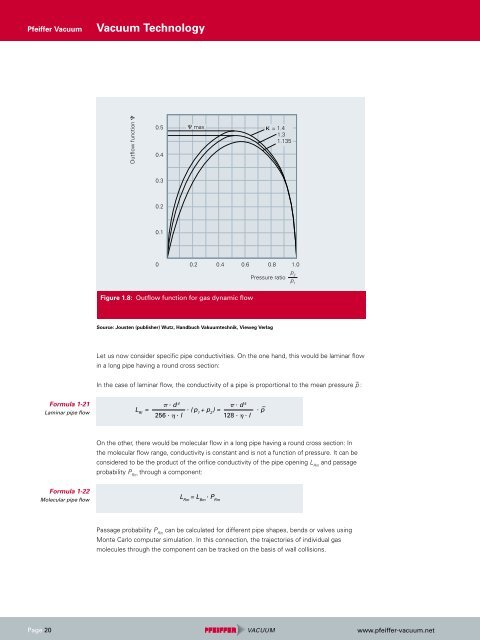You also want an ePaper? Increase the reach of your titles
YUMPU automatically turns print PDFs into web optimized ePapers that Google loves.
Pfeiffer <strong>Vacuum</strong><br />
Page 20<br />
Formula 1-21<br />
Laminar pipe flow<br />
Formula 1-22<br />
Molecular pipe flow<br />
<strong>Vacuum</strong> <strong>Technology</strong><br />
Outflow function C<br />
0.5<br />
0.4<br />
0.3<br />
0.2<br />
0.1<br />
C max k = 1.4<br />
1.3<br />
1.135<br />
0 0.2 0.4 0.6 0.8 1.0<br />
Figure 1.8: Outflow function for gas dynamic flow<br />
Pressure ratio<br />
Source: Jousten (publisher) Wutz, Handbuch Vakuumtechnik, Vieweg Verlag<br />
Let us now consider specific pipe conductivities. On the one hand, this would be laminar flow<br />
in a long pipe having a round cross section:<br />
In the case of laminar flow, the conductivity of a pipe is proportional to the mean pressure p – :<br />
p . d 4 p . d 4<br />
L Rl = . ( p 1 + p 2 ) = . p –<br />
256 . � . l 128 . � . l<br />
On the other, there would be molecular flow in a long pipe having a round cross section: In<br />
the molecular flow range, conductivity is constant and is not a function of pressure. It can be<br />
considered to be the product of the orifice conductivity of the pipe opening L and passage<br />
Rm<br />
probability P through a component:<br />
Rm<br />
L Rm = L Bm . PRm<br />
Passage probability P can be calculated for different pipe shapes, bends or valves using<br />
Rm<br />
Monte Carlo computer simulation. In this connection, the trajectories of individual gas<br />
molecules through the component can be tracked on the basis of wall collisions.<br />
p2 p1 www.pfeiffer-vacuum.net

















